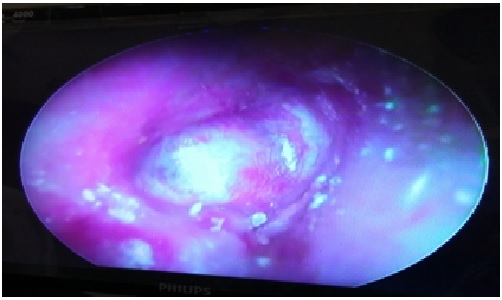Interlay myringoplasty: hearing gain and outcomein large central tympanic membrane perforation
Abstract
Background: Tympanic membrane Perforations primarily results from middle ear infections and myringoplasty is a surgical procedure used to repair the tympanic membrane and to improve hearing. The interlay technique is a newer safe and technique that has shown higher success rates and is considered better than both overlay as well as the underlay techniques.
Aims and objectives: To analyze the results of interlay myringoplasty, in terms of graft uptake and hearing improvement in cases of chronic suppurative otitis media with inactive mucosal disease with large central perforation.
Materials and Methods: This is a prospective study conducted from August 2015 to January 2018 in 60 patients of chronic suppurative otitis media (CSOM) with large central perforation. All patients underwent interlay myringoplastythrough post aural approach after clinical examination, audiometric tests & routine investigations. Patients were called for regular follow up for 12 weeks.
Results:The graft uptake rate in the present study was found to be 93.33%, Pre operatively mean air bone gap was 28.5±6.96 dB and Post operatively after 12 weeks mean air bone gap improved to 15.83±3.37.
Conclusion: Interlay myringoplasty with a superiorly based TM flap is an effective technique over conventional methods in terms of both graft uptake as well as hearing improvement in large central perforation.
Downloads
References
2. Kawatra R, Maheshwari P, Kumar G. A comparative study of the techniques of myringoplasty – Overlay, underlay & interlay. IOSR J Dent Med Sci. 2014;13:12-6.[pubmed]
3. Bluestone CD, Cantekin EI, Douglas GS.Eustachian tube function related to the results of tympanoplasty in children. Laryngoscope. 1979 Mar;89(3):450-8.doi:10.1288/00005537-197903000-00013.[pubmed]
4. Jain S, Gupta N, Gupta R, Roy A. Interlay Type I tympanoplasty in large central perforations: Analysis of 500 cases. Indian J Otol 2017;23:32-5.
5. Guo M, Huang Y, Wang J. Report of myringoplasty with interlay method in 53 ears perforation of tympani. Lin Chuang Er Bi Yan Hou Ke Za Zhi. 1999 Apr;13(4):147-9.[pubmed]
6. Komune S, Wakizono S, Hisashi K, Uemura T. Interlay method for myringoplasty. Auris Nasus Larynx.1992;19(1):17-22.[pubmed]
7. Patil BC, Misale PR, Mane RS, Mohite AA. Outcome of interlaygrafting in type 1 tympanoplasty for large central perforation. Indian JOtolaryngol Head Neck Surg. 2014;66:418 24.doi:10.1007/s12070-014-0741-3.[pubmed]
8. Wullstein H, Theory And Practice Of Myringoplasty. Laryngoscope. 1956 Aug;66(8):1076-93.doi:10.1288/00005537-195608000-00008.[pubmed]
9. Hussain A, Yousaf N,Khan AR. Outcome of myringoplasty. Jrnl of PG Med Inst Peshawar 2004;18(4):695-8.
10. Singh M, Rai A, Bandyopadhyay S, Gupta SC. Comparative study of the underlay andoverlay techniques of myringoplasty in large and subtotal perforations of the tympanicmembrane. J Laryngol Otol. 2003 Jun;117(6):444-8.doi:10.1258/002221503321892262.[pubmed]
11. Hay A, Blanshard J. The anterior interlay myringoplasty: Outcome and hearing results in anterior and subtotal tympanic membrane perforations.Otol Neurotol. 2014 Oct;35(9):1569-76. DOI:10.1097/MAO.0000000000000503.

Copyright (c) 2018 Author (s). Published by Siddharth Health Research and Social Welfare Society

This work is licensed under a Creative Commons Attribution 4.0 International License.


 OAI - Open Archives Initiative
OAI - Open Archives Initiative



















 Therapoid
Therapoid

